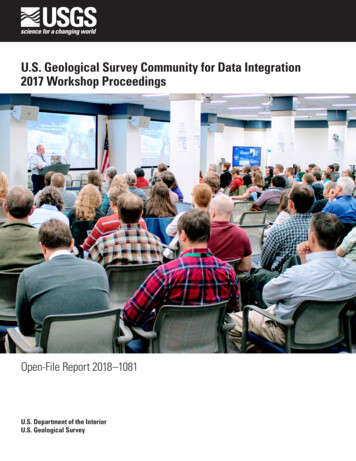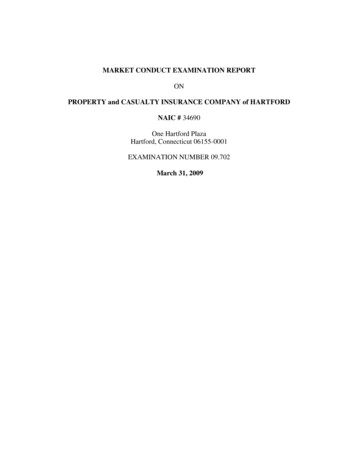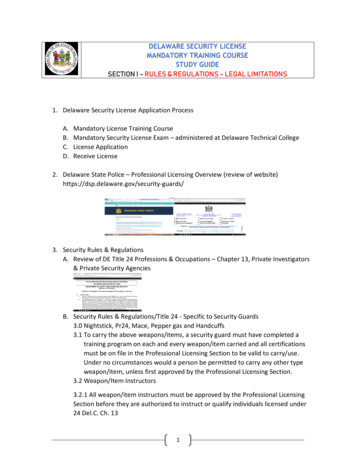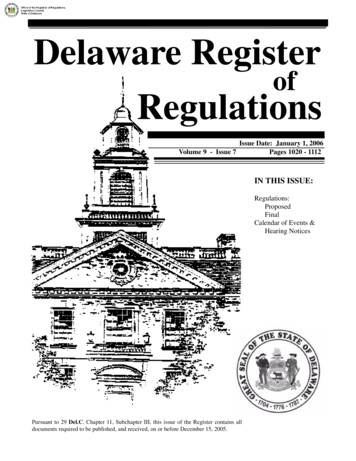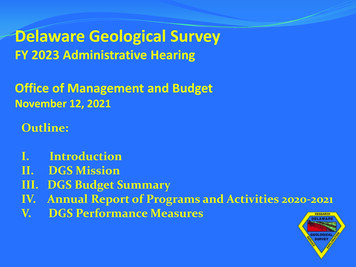
Transcription
Delaware Geological SurveyFY 2023 Administrative HearingOffice of Management and BudgetNovember 12, 2021Outline:I.II.III.IV.V.IntroductionDGS MissionDGS Budget SummaryAnnual Report of Programs and Activities 2020-2021DGS Performance Measures
Delaware Geological Survey’s Mission: Our focus is value-added science for public needs Program built on 5 primary areas:(1) water resources(2) geology & mapping(3) natural hazards(4) information and data dissemination
FY 2023 DGS Budget Request SummaryCategoryFY2022 FinalBudgetFY2022 BaseAdjustmentFY2022 BaseOne TimeRequestFY2023 RequestOPERATIONS 002751986.219.42005.602005.6OPERATIONS .300127.3127.32,113.52,132.90.0Operating Appropriation History2,0001,5001,000Fiscal YearGF2023020225002021Dollars in Thousands ( )2,50019.42019TOTAL2020RIVER MASTER 0047555352 GrantsRIVER MASTER SUMMARY2,132.9
(Please refer to attachedcopy of Annual Report ofPrograms & ault/files/annual report/DGS Annual Report 2020-2021.pdf
DGS has hired 150 students over the past20 years. Many have gone on to becomeprofessors, consultants, engineers, andmanagers.
DGS Performance Measures
QUESTIONS?
Delaware Geological SurveyANNUAL REPORT OFPROGRAMS & ACTIVITIES2020-2021
Above photo: DGS drill rig and supporting equipment at a recent drill site.Front cover photo: DGS well driller, Paul “Steve” McCreary, operating the DGS drill rig.Credit for both photos: Stephen Badger, Public Affairs Officer, Maryland Department of Natural Resources.OUR MISSIONThe Delaware Geological Survey’s mission is, by statute,geologic and hydrologic research and exploration, and dissemination ofinformation through publication and public service.Delaware Geological SurveyDGS Building257 Academy StreetUniversity of DelawareNewark, DE 19716-7501www.dgs.udel.eduAnnual Report of Programs & Activities2
Message from the DirectorThis past year has been especially challenging for many of us as we adaptedto new, school, work and life schedulesrelated to the COVID-19 pandemic. Itwould have been even more challengingif not for the front-line workers whoserved the public, sometimes as volunteers. Like these professionals, we allhave opportunities to serve the groupsor professions that are important to us,or define us.One important component of theDelaware Geological Survey’s missionis service. Service can be defined inmany ways. For example, DGS staffoften work closely with representativesfrom local government agencies andcommunities to provide expert technical assistance and advice for issuessuch as storm water management,ground-water protection, and characterizing site-specific geologic conditions in areas of interest. We also workclosely with our sister state agencies,such as the Delaware Department ofNatural Resources and EnvironmentalControl and the Delaware Departmentof Transportation, by providing scientific and technical advice, and technicalreview of reports. DGS often performsscientific studies on behalf of theseagencies, with the new knowledge andfindings providing these agencies withthe needed information for planninginfrastructure, or providing information for developing fair, but effectiveregulations.the Center for the Inland Bays, as wellas federal advisory boards for nationalprograms, such as the Federal AdvisoryCommittee for the U.S. GeologicalSurvey’s National Cooperative Geologic Mapping Program.Another important type of service weperform is participating in professionalorganizations, associations, and societies that contribute to the professionand study of geology, and support andenhance the public’s understandingof the geosciences. Scientific societiesfoster opportunities to share the resultsof research, collaborate on projects andinitiatives, enhance professionalism andethics, recognize outstanding peers byawards and citations, and recruit andmentor young scientists in the profession of geology.DGS also has statutory roles forassisting the state, where staff serve onboards and commissions such as theGovernors Water Supply CoordinatingCouncil, as well as the state boards oflicensure for professional geologistsand well drillers, respectively. DGS staffalso serve on the boards of non-profitenvironmental organizations such asFrom my own personal experience, Iwill soon be completing my term asPresident of the American GeoscienceInstitute (AGI), a confederation of over50 geoscience societies and organizations that represents over 250,000geoscientists worldwide. AGI plays acritical role in assessing employmenttrends and opportunities for geoscientists, monitoring relevant legislation,and assessing trends in both K-12 andpost-secondary education. On thebroader scale, AGI has been a leaderin generating events and activities thathighlight the importance of geologyto society. The best example of thiseffort is the establishment of NationalEarth Science Week, which is usuallycelebrated during the second week ofOctober each year. AGI provides EarthScience Week “Toolkits” that containlesson plans, reference materials, andlearning guides for K-12 teachers. Itis estimated that AGI’s Earth ScienceWeek education efforts reach out to 50million people each year world-wide.Annual Report of Programs & Activities1These examples demonstrate that DGSstaff perform service for a wide anddiverse assemblage of stakeholders thatrange from local partners to international institutions. As such, our serviceactivities are valuable, fulfilling, andworthwhile. DGS staff are leaders onmany fronts, and we are often recognized for our exemplary service activities. Moreover, our staff receive thesatisfaction of promoting and enhancing our profession, often as volunteers,while simultaneously contributing totheir own professional growth. Theback page of this report has a completelisting of the various organizationsfor which DGS staff provide servicein some capacity. We are proud of theservice we provide to our stakeholders,agencies, and non-profit partners, aswell as to our profession.One of my duties as President of AGI was topresent AGI‘s annual awards to outstandingscientists and leaders. The 2021 Medal inHonor of Ian Campbell, AGI’s highest award,is presented to Dr. Marcia McNutt, for her superlative service to the geosciences. Marciaserved as the Director of the U.S. GeologicalSurvey, and is currently the President of theNational Academy of Sciences.David R. WunschDirector and State Geologist
1. Water ResourcesDelaware Groundwater Monitoring NetworkProject Contacts: Changming He, A. Scott Andres,Rachel W. McQuiggan, and Thomas E. McKennaDGS currently monitors groundwater levels in anetwork of wells that support multiple uses by theenvironmental management, engineering, watersupply, and science communities.Groundwater is the backbone of Delaware’s water resources,serving the water needs of the public, the economy, andour natural environment. As such, groundwater monitoring is a necessary, but resource-intensive program of theDGS. The Delaware Groundwater Monitoring Network isthe umbrella program used by DGS to coordinate monitoring activities and leverage institutional resources andstaff expertise. Since the 1960s, the DGS has maintaineda network of wells that are used for groundwater level andgroundwater quality observations. We have been workingfor nearly 20 years to replace wells, often poorly located andnot constructed for monitoring purposes, with strategicallylocated, designed, and instrumented monitoring wells. Amodern database-management and data-distribution systemserves the DGS and stakeholders. Consultants, governmentagencies, researchers, and well drillers use these data toevaluate groundwater availability, chemical characteristics,contamination, among other issues.Long time-series of water levels in major aquifers informwater-resource management through analyses of aquifer responses to pumping, climatic variability, drought, seawaterintrusion, and interaction with streams and their ecosystems. DGS staff members regularly monitor more than 100wells in 13 different aquifers used for water supply. Most ofthese wells are equipped with automated pressure and temperature sensors that record data every 15 minutes. A smallnumber of wells are equipped with automated conductivitysensors to help track if saltwater problems are developing.Monitoring methods are adapted from protocols from theU.S. Geological Survey (USGS), the U.S. EnvironmentalProtection Agency (USEPA), programs in other states, andour own experience and expertise.As of July 2021, our data resource holds nearly 495,000records of manually measured water levels and daily averagewater levels derived from almost 4,800 wells. Self-service access to these data and statistical products are available fromhttps://www.dgs.udel.edu/water-resources. In addition,DGS works cooperatively with the Delaware Solid WasteAuthority and the Delaware Environmental Observing System to provide telemetered real-time data from four wells.We also provide groundwater-level and groundwater-qualityDGS Projects & Activities Summary2
data from more than 50 Delaware wells to the NationalGround Water Monitoring Network (www.cida.usgs.gov/ngwmn), a network of over 30 state and regionally operatedgroundwater monitoring programs.We currently manage nearly 30 million water-level recordscollected by automated pressure sensors and are adding over1.5 million new records to this dataset every year. Morethan 8.9 million groundwater temperature and 4.9 millionsalinity records measured by automated sensors are in ourwater-quality dataset. DGS has been increasing our effortswith collection and laboratory testing of water samples andwe now hold results of 5,464 samples from 641 wells. Manyof the lab test data are part of specific publications and areavailable from the data tab of the DGS website (https://www.dgs.udel.edu/data).Delaware Water-Quality Monitoring NetworkDGS staff member, Rachel McQuiggan, measuring water levels forthe Delaware Groundwater Monitoring Network.Project Contacts: Changming He, Rachel W. McQuiggan,and A. Scott AndresProject WiCCEDGroundwater sampling to test water quality in Delaware’s major aquifersProject Contacts: A. Scott Andres andRachel W. McQuigganLike the other Mid-Atlantic States, Delaware is facing thechallenge of potential degradation of water quality due toever-growing human activities as well as saltwater intrusioninduced by sea-level rise. In April 2021, the DGS added a newwater-quality component to the Delaware Groundwater Monitoring Network. The goals of this project are to characterizethe groundwater quality and to identify trends and changes ingroundwater quality within the state’s major aquifers.Project leverages other DGS monitoring to investigategroundwater salinization and eutrophicationDGS staff members Rachel McQuiggan and Scott Andresare participants in an ongoing National Science FoundationCurrently, the groundwater-quality monitoring networkconsists of over 70 wells covering 13 major aquifers. Wellselection includes background wells and wells installed inaquifers within the state where water use has either changedor is expected to change in the near future. Each well will besampled every five years and analyzed for basic groundwatergeochemical constituents (major ions and select metals) andstable isotopes (2H and 18O).In 2021, DGS staff collected groundwater samples from 18monitoring wells in eight of Delaware’s major water-supplyaquifers including the Columbia, Rancocas, Mt. Laurel, Magothy, Potomac, upper Choptank, Manokin, and Pokomokeaquifers. Over time, we will establish ambient water qualityin the aquifers and observe water-quality trends that mayaffect stakeholders. This project is under contract with theSource Water Protection Program in the Delaware Department of Natural Resources and Environmental Control(DNREC) and is funded through a grant from the USEPA.Annual Report of Programs & ActivitiesZach Garmoe (CIB; left) and Scott Andres (right) deploying water-quality monitoring equipment at a station on Guinea Creek.3
EPSCoR-funded effort, Water in the Changing Coastal Environment of Delaware (Project WiCCED). Project WiCCEDis a consortium of scientists and educators from the Universityof Delaware (UD), Delaware State University, Wesley College,and Delaware Technical and Community College.More than 50 monitoring wells were installed at 12 sitestotaling over 8,800 linear feet. Pressure-temperature-conductivity and pressure-temperature sensors operated in wellsand tidal streams collected more than 2 million observations. These resources will continue to be monitored for theforeseeable future.As part of Project WiCCED, the DGS and the DelawareCenter for the Inland Bays (CIB) added one additional water-quality monitoring station at a dock on Guinea Creek.There are now three jointly operated water-quality stationsin the Inland Bays, with one on the Indian River near ShortsLanding and one on Vines Creek. Every half hour thestations measure tide height, temperature, salinity, dissolvedoxygen, turbidity, pH, and plant pigments chlorophyll a andphycoerythrin. The work has allowed the team to quantifythe frequency and duration of hypoxic events and their relationships to other water-quality and flow variables. Hypoxia, flow, and water quality are key metrics for the Delaware’swater-quality program, and the CIB’s prioritization andtargeting of management and mitigation practices.Seventy-six groundwater samples were collected from project monitoring wells for laboratory analysis. These wells willbe incorporated into the Delaware Groundwater QualityMonitoring Network.Pumping of the Piney Point aquifer in the Dover area hasreduced water levels more than 80 feet over the past 50 yearsin several wells in the Dover area. Dover Water and Wastewater has since modified their use of the Piney Point andslowed the rate of water-level decline. Continued monitoring and development of new groundwater flow modelsare recommended to identify and test possible solutions tothese problems.Similarities in hydrographs, potentiometric surface mapsand time series of head differentials between the Frederica, Federalsburg, and Cheswold aquifers indicate thatthey function as a single, leaky, layered aquifer. Pumpinghas reduced water levels in these three aquifers below sealevel over large areas of Kent County and has caused flowdirections to change from a general southeasterly directionin pre-development times to flow directed toward pumpingcenters. Water-quality data support the interpretation thatflow directions have changed in response to pumping. Thesefindings indicate no immediate threats to the aquifers, butdo undersore the need for continued monitoring and tomanage these aquifers as a single resource rather than asindividual aquifers.More information can be found on the project website:www.projectwicced.org.Groundwater and Saline Water Intrusion Monitoring Network Infrastructure Improvements:Kent County, DelawareProject Contacts: A. Scott Andres, Rachel W. McQuiggan,Changming He, and Thomas E. McKennaEvaluating long-term monitoring data and trackinggroundwater and surface-water conditions in an areathat has significant water availability issuesThe DGS has completed a multi-year project to install newwater-monitoring infrastructure and collect baseline data inKent County, Delaware. Recommended by the Water SupplyCoordinating Council in 2015, the project was funded bya fiscal year 2017 State of Delaware Capital Appropriation.Expansion of water-monitoring infrastructure in Kent County was deemed critical because infrastructure was sparse andbecause population, economic and environmental conditions,and agricultural practices (irrigation) have changed how weuse water since regional studies were completed in the 1960sand 1970s. In addition, sea-level rise is increasing the riskof salinization of fresh water resources. Also, we now have amore detailed understanding of aquifers and confining bedsand vastly improved computer methods to simulate, analyze,and predict the availability of groundwater and the impacts ofincreased groundwater use.Annual Report of Programs & ActivitiesIntensive field study of several pond and well-sourced watersupplies in the east Dover area identified the hydrogeologic,pumping, and climatic factors that increase the risks forsaltwater intrusion. These factors include 1) close proximityor a surface connection to a body of salty surface water, 2)spring tides, 3) tropical and extra-tropical storms that raisetide elevations, 4) a low permeability, unconfined aquifer,and 5) pumping. It usually requires the presence of morethan one of these risk factors to initiate saltwater intrusion.In the near term, careful modification of pumping schedulescan substantially minimize risk of saltwater intrusion intosome at-risk water supplies that use the Columbia (watertable) aquifer. In light of long-term sea-level rise predictions,it is certain that simple changes to pumping schedules willnot be sufficient to stop saltwater intrusion from damagingsome at-risk water supplies that use the Columbia aquifer.4
Long-term declines in annual minimum total flow and baseflow at streamflow gaging stations in the Beaverdam Branchand Marshyhope Creel watersheds and associated long-termincreases in annual precipitation, number of growing days,irrigated acres, and number of irrigation wells in those basins are consistent with the interpretation that the combinedeffects of irrigation pumping from the Columbia aquiferand climate change are reducing groundwater discharge tothose streams. Long-term declines in annual minimum totalflow and baseflow were not observed at the St. Jones Riverat Dover gaging station where there are similar climatic conditions but fewer irrigation wells and irrigated acres. Thesefindings underscore the need for continued monitoring andassessment of streamflow and irrigation pumping. The firsttwo reports from this project are available as DGS OpenFile Reports 52 and 53 with associated DGS digital dataproducts. A third report, DGS Report of Investigations No.85, is in the final stages of publication.toring stations for DNREC Watershed Assesment Sectionon the Brandywine Creek at Wilmington, Christina Riverat Newport, Appoquinimink River near Odessa, MillsboroPond Outlet at Millsboro, and Massey Ditch at MasseyLanding; intensive water-quality monitoring on the Murderkill River near Frederica for Kent County; and a three-yearproject with the Delaware Department of Transportation(DelDOT) to integrate USGS and DelDOT real-time datastreams through testing and use of data-logger technology.The DGS adds significant value to projects undertaken forDelaware agencies by the USGS by ensuring appropriatecoordination and scoping of work and technical review ofproducts before contract payments are released.Stormwater Infiltration BMP Impacts onGroundwater QualityProject Contacts: Rachel W. McQuiggan andA. Scott AndresDelaware Stream and Tide Gage ProgramMonitoring and evaluating the impacts of winterdeicing salt transport to groundwaterProject Contacts: Stefanie J. Baxter and Kelvin W. RamseyIn cooperation with DelDOT, the DGS has been monitoring groundwater and stormwater at a roadside site and aDelDOT-managed stormwater infiltration basin to charac-Ongoing DGS program to advise state and localagencies on stream conditions and flooding on thebasis of a cooperative DGS-USGS program to operatestream and tide gagesThe USGS, in cooperation with the DGS, has been operating and maintaining continuous-record stream andtide gages throughout Delaware for decades. This year, tenstreamgages and seven tide gages were operated for theprogram. The data are used for water-resource planning andmanagement, evaluation of drought conditions, and floodforecasting, warning, and response, including early warningsystems. The warning systems are used by the DGS, Delaware Emergency Management Agency (DEMA), all threecounty emergency management offices, most municipalities,and the National Weather Service.The DGS also assists other Delaware government agencies by coordinating USGS resources through the DGSUSGS cooperative program related to water resources.This includes coordinating the continued operation andmaintenance of real-time streamflow gages for the DNRECWatershed Assesment Section at Millsboro Pond Outletat Millsboro, Beaverdam Ditch near Millville, and SilverLake Tributary at Middletown, tide gages at Indian River atRosedale Beach and Indian River near Bethany Beach, andone tide and discharge gage on the Murderkill River at Bowers. Also included in the DGS-USGS cooperative programis the operation and maintenance of water-quality moniAnnual Report of Programs & ActivitiesMap showing locations of two different stormwater managementareas. The Summit Bridge site is located at a roadside area neara major intersection. BMP 663 is a DelDOT-managed infiltrationbasin that receives stormwater from a highway and nearby roads.Both sites are located in recharge areas.5
The Coastal Critical Zoneterize the impacts of deicing salt on groundwater. We havebeen operating and maintaining automated, high-frequency stormwater flow and salinity, as well as groundwaterpressure, temperature, and electrical conductivity/salinitysystems at both sites for over two years. This project wasprompted by increasing chloride concentrations in a number of groundwater-supplied public water systems in NewCastle County and occurrences of radium in several of theimpacted water sources.Project Contact: Rachel W. McQuigganStudying coastal processes to understand critical feedbacks related to climate changeThe critical zone includes all Earth processes from the treecanopy down to bedrock. In Delaware, coastal marshes playan important role in the critical zone by storing carbon, nutrients, and other contaminants. Sea-level rise is expandingthe marshes, but also salinizing soil and shallow groundwater, which can damage adjacent forests and farm crop fields.Data from groundwater samples, stormwater and groundwater sensors, and subsurface geophysical surveys allowedus to develop and test conceptual models of the movementof water and salt from drainage networks into groundwater. We have collected over 1.7 million water level andelectrical conductivity/salinity records, 400,000 stormwater inflow measurements, 4 rounds of groundwatersampling at project wells, and 39 stormwater and surfacewater samples.DGS researcher Rachel McQuiggan joined a NSF-funded project investigating the hydrological, biogeochemical,ecological, and geomorphological processes in the coastalMid-Atlantic region. UD’s Department of Earth Sciencesprofessor, Dr. Holly Michael, is the lead primary investigator(PI) for the research, which is called The Coastal CriticalZone: Processes that transform landscapes and fluxes betweenland and sea. The cluster group of additional researchersincludes other UD staff and faculty as co-PIs, as well as collaborators at Wesley College, University of Maryland, GeorgeWashington University, Virginia Institute of Marine Science,and Boston University. McQuiggan will act as data managerfor the coastal group, assisting with processing, management,storage, and dissemination of field and experimental data.Extensive use of inexpensive in-situ measurements ofelectrical conductivity/salinity made by automated sensorshas greatly improved data resolution and our ability todevelop and test conceptual models, while reducing thetime and money needed for collection and laboratorytesting of samples. Empirical relationships between sensorand laboratory-measured data from this study are very wellcorrelated showing that sensors are reliable and cost effective for monitoring movement of salty water. Using sensorsand geophysical logging, we observed saltwater migratingthrough different layers within the aquifer and found thatspeed and pathways of saltwater movement depend onhydraulic properties of geologic units.Six project study sites have been instrumented with longterm water, soil, air, vegetation, and land surveying monitoring equipment. Study sites are located in Delaware,Maryland, and Virginia, and focus on the transition zonesbetween marsh, forest, and agriculture. This project willshare monitoring resources with the NSF-funded EPSCoRProject WiCCED, which is also investigating groundwatersalinization in the east Dover area.Groundwater chemistry indicates two mixing processesoccur; -one that occurs as salty stormwater infiltrates tothe water table and moves downgradient from the basin,and the other as dilute stormwater flushes through duringlate summer and fall. Monitoring at the two sites willcontinue through another winter season and an additionalround of groundwater sampling will help refine our conceptual model to account for salt movement over multipleseasons. Data from this work will support developmentof statistical and simulations tools to evaluate the risks ofdeicing on groundwater. Key to the effort has been the establishment of empirical relationships between inexpensivefield measurements of electrical conductivity/salinity andmore time-consuming and expensive laboratory-measuredchloride concentrations.Annual Report of Programs & ActivitiesGhost forest near east Dover, Delaware. Ghost forests are indicators of salty water from marshes encroaching into forestedareas resulting in dead and dying trees.6
Blue Carbon Storage in the Blackbird Creek andSt. Jones River EstuariesSt. Jones River coastal marsh networks in Delaware. This wasaccomplished by collecting sediment core samples across anarray of vegetation types and hydrologic settings within thetwo wetland networks. Core samples were then analyzed fortheir bulk density and organic matter content, which wereused to estimate the density of organic carbon within theupper 30 centimeters (cm) for each square meter of marshsurface. Carbon density was then scaled across the marshesby fitting ensembles of statistical models between observedcarbon density values and geospatial data including terrainderivatives, LiDAR metrics, and spectral vegetation indices.Project Contacts: Daniel L. Warner, John A. Callahan,and Thomas E. McKennaStudying blue carbon storage in coastal wetlandsto help inform state policy regarding sustainabilitytargetsCoastal salt marshes are known to store and accumulatelarge quantities of organic carbon relative to other ecosystem types, making them of great importance to the globalcarbon cycle. However, estimating carbon storage in thesesystems is challenging due to the spatial heterogeneity ofthe sediments in the marsh network. The State of Delawarehas extensive coastal marsh networks that are subjected toincreasing ecological pressures such as a relatively rapid rateof sea-level rise, land use change within coastal watersheds,and potential changes in storm surges.We estimated that the marsh soils store roughly 70 and 79Gg (millions of kilograms) of organic carbon in the upper30 cm of sediments in the Blackbird and St. Jones estuaries,respectively. However, carbon storage through the wholesoil profile, which can be several meters deep, is likely muchhigher. We found that although some areas of particularlyhigh carbon storage may lie above a zone of frequent tidalinundation, these areas may be threatened by increasederosion due to boat traffic along tidal channels and increasesin relative sea level in the coming decades. Protecting thestored organic carbon in coastal ecosystems may improveecosystem health and ensure that the carbon accumulationthat has built up over centuries remains sequestered.Quantifying stored carbon in these ecosystems and assessingits potential vulnerability to ecological pressures is of greatinterest to the state in its strategic planning for climate changemitigation and carbon budgeting efforts. In this study, weaimed to model and map high resolution predictions ofstored organic matter and carbon in the Blackbird Creek andMaps of predicted patterns of organic matter density in the upper 30 cm of marsh sediments in Blackbird Creek (left) and St. Jones River(right) estuaries. Low values are illustrated in green while high values are in brown. Organic matter density is calculated as the percentageof organic content of sediments by weight normalized to the sediment bulk density. This can then be used to predict total organic matterand organic carbon storage in the marsh ecosystems.Annual Report of Programs & Activities7
2. Geology & MappingMiddle Atlantic Coastal Plain StratigraphicReconciliation InitiativeProject Contacts: Peter P. McLaughlin andKelvin W. RamseyUSGS-funded multistate initiative to establishequivalency of geologic unitsThe DGS is leading a multi-state, multi-organization project,the Middle Atlantic Coastal Plain Stratigraphic ReconciliationInitiative (“MAtStrat”), to establish consistent recognition ofgeological formations at a regional scale across the Coastal Plainof four states: Virginia, Maryland, Delaware, and New Jersey.This project is supported by the U.S. Geological Survey’s National Geologic Map Database Project, NGMDB, which makesresources available including an online digital map databasefor the nation and an up-to-date list of geological formationsrecognized around the country (“stratigraphic lexicon”). TheMAtStrat Project will support the NGMDB Project in its mission by clarifying equivalencies of geological formation namesbetween the four states, which will help with problems suchas reconciling stratigraphic nomenclature issues across stateboundaries on geologic maps.Each of the states in the project area has its own system ofdefining geologic formations but there is no well-establishedor documented consensus on precisely translating the definitions of these units across state lines. This lack of establishedinterstate geological equivalencies can result in confusionwhen comparing geological maps at state bo
DGS. The Delaware Groundwater Monitoring Network is the umbrella program used by DGS to coordinate mon-itoring activities and leverage institutional resources and staff expertise. Since the 1960s, the DGS has maintained a network of wells that are used for groundwater level and groundwater quality observations. We have been working

